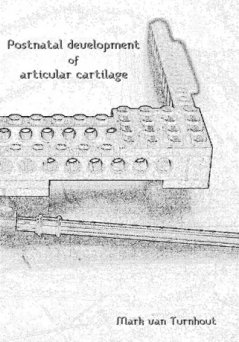Postnatal development of articular cartilage
Articular cartilage (AC) is the thin layer of tissue that covers the ends of the bones in the synovial joints in mammals. Functional adult AC has depth-dependent mechanical properties that are not yet present at birth. These depth-dependent mechanical properties in adult life are the result of a depth-dependent composition and structure that develops in postnatal life. Our knowledge on how postnatal AC remodelling proceeds, and how the functional depth-dependent mechanical properties develop in postnatal life is still limited.

In this thesis, we investigated the properties of the postnatal collagen network in AC, and the contribution of postnatal collagen network remodelling to the adult depth-dependent mechanical properties of AC. We used horses and (mostly) sheep as experimental animals to obtain measurements on three parameters of the postnatal collagen network (predominant collagen fibril orientation, collagen densities and collagen network anisotropy). We used a composition-based finite element model for computational analysis of the role of this collagen network in the postnatal development of depth-dependent mechanical properties.
We first investigated how collagen structure in AC affects the parameters that are measured by quantitative polarised light microscopy (qPLM), because qPLM is the most popular technique to investigate properties of the collagen network in AC. We quantified the contributions of the three collagen network parameters (orientation, density and anisotropy) to the measured predominant fibril orientation and the measured total tissue birefringence (retardance), and showed that collagen network anisotropy can be quantified when the retardance from polarised light microscopy is corrected for collagen densities.
In the study on horses, we investigated differences in predominant collagen orientation for equine articular cartilage in stillborn and adult animals with scanning electron microscopy and quantitative polarised light microscopy (qPLM). In the study on sheep, we first investigated the predominant collagen orientation in animals divided over ten sample points between birth and maturity (72 weeks) with qPLM.
Both studies confirmed the remark by Archer et al. [Archer2003] that the collagen fibrils in perinatal animals lie predominantly parallel to the articular surface, and we confirmed and quantified the adult `Benninghoff' structure in the mature animals in both studies. We further observed a transitional layer with weak fibril anisotropy in the perinatal animals that is not correlated to changes in predominant collagen fibril orientation as in the adult Benninghoff structure.
To investigate the contribution of collagen reorientation to the development of depth-dependent mechanical properties, we implemented the results on postnatal predominant collagen fibril orientation in the sheep in a composition-based finite element model. We described the interactions between collagen orientation, free swelling strains, osmotic pressures and effective AC stiffness in confined compression.
Based on the results, we hypothesised that collagen densities increase most in the deep tissue due to increased collagen fibril strains that result from postnatal collagen fibril reorientation.
In sheep, we measured collagen densities with Fourier transform infrared micro-spectroscopy. Collagen density increased in postnatal life, and they increased most in the deep tissue (near the bone), which supported our earlier hypothesis. Perinatal animals showed a valley in collagen densities near the articular surface, i.e. at the position of the transitional layer. We showed that this valley disappears in early postnatal life. We corrected the qPLM retardance from our sheep data with the collagen densities from the sheep data to assess collagen network anisotropy. The results showed that anisotropy is relatively constant in the deep tissue, and that anisotropy is stronger in the transitional layer of perinatal animals compared with the transitional layer of adult animals.
To investigate interactions in postnatal collagen network remodelling, we implemented the three collagen network parameters (orientation, density and anisotropy) that we obtained from the sheep in the finite element model. Based on the results, we suggested different functional roles for the three collagen network parameters: collagen fibril reorientation contributes most to the development of depth-dependent mechanical properties, collagen density increases appear to equalise collagen fibril strains, and the weak anisotropy in the transitional layer appears to smooth gradients in the mechanical state of the tissue in adult animals.
[Archer2003] Archer, C. W.; Dowthwaite, G. P. & Francis-West, P.
Development of synovial joints. Birth Defects Research Part C: Embryo
Today: Reviews, 69(2):144-155, May 2003.